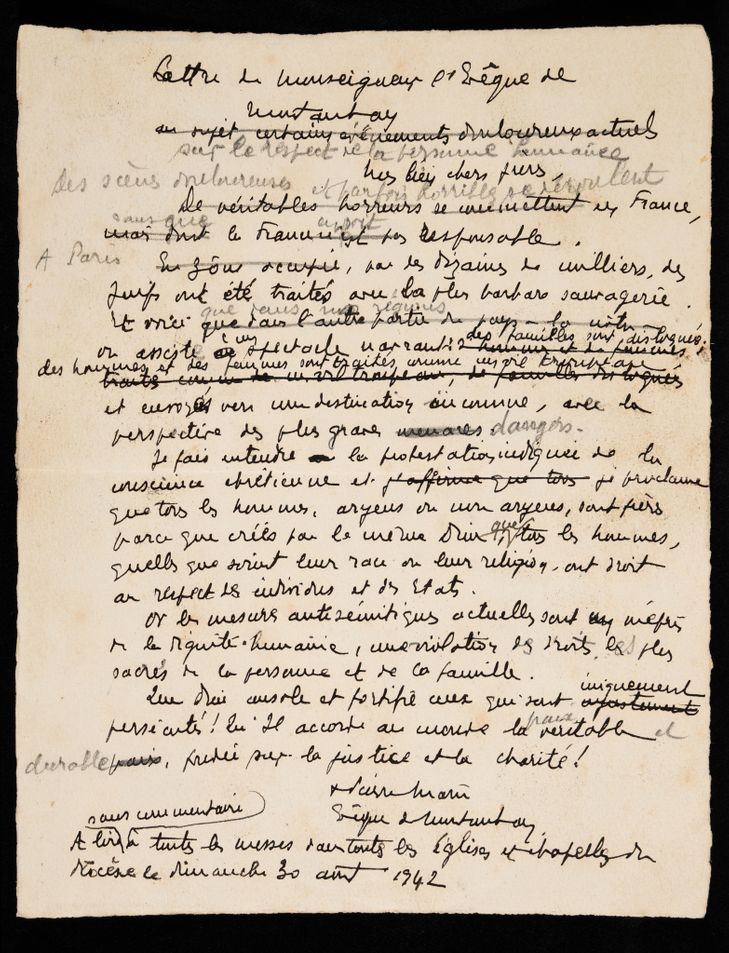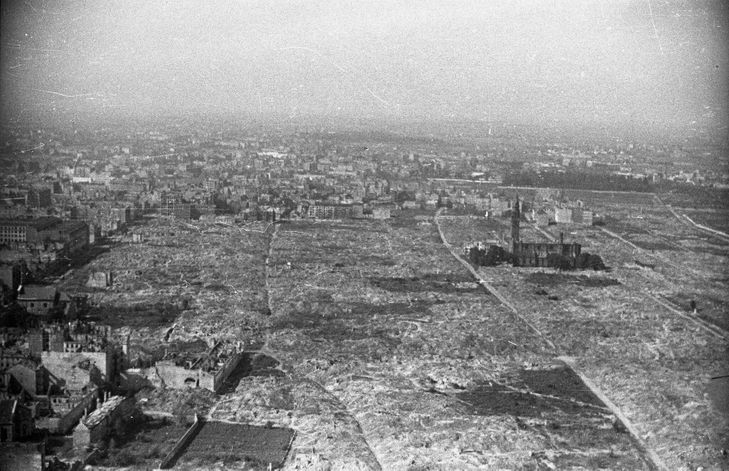Letters from bishops and nuncios, photographs of deported ecclesiastics, objects from internment camps, presented in a labyrinthine route and under careful lighting… Eighty years after the roundups in the summer of 1942, including that of the Vél’ d’Hiv, the Shoah Memorial is devoting an unprecedented exhibition to the attitude of the Christian Churches towards the genocide of the Jews, in France but also elsewhere in Europe. And defends the virtues of a plural approach.
“It was important not to essentialize each of the Churches, which are not monolithic blocks. Behind them, we are dealing with men and women,” argues the scientific curator of the exhibition, Nina Valbousquet, member of the French School of Rome. The chronology is also important. “The attitude of the men of the Church in 1940-1941 is not that which will follow the turn of the summer of 1942.”
According to the historian, it was first the ” overconfidence ” in the regime of Marshal Pétain, against a background of persistent Christian anti-Judaism, which characterizes the attitude of a Catholic institution adapting to the first anti-Jewish laws. The Confessing Press, including daily The cross, admittedly subject to censorship, will not condemn them either. The “second status of the Jews” of June 1941, aligned with the most racialist Nazi measures, further tested the “Marshalism” of the Church. The criticisms are first voiced behind the scenes.
“Burning Sympathy”
But as early as March 1941, a private letter sent to Chief Rabbi Isaiah Schwartz by Marc Boegner, president of the Reformed Church and of the Protestant Federation of France, had a certain echo after having been widely relayed in the unoccupied southern zone. ” Our Church, which once knew the sufferings of persecution, feels an ardent sympathy for your communities whose freedom of worship is already compromised in certain places and whose faithful have just been so suddenly thrown into misfortune”, writes the pastor there.
“Protestants don’t have the same history with Judaism, the same chronology as Catholics. It is a minority nourished by the Old Testament, and which remembers the Dreyfus affair. at the turn of the century, deciphers Patrick Cabanel, historian of Protestantism.
Among Catholics, underlines the exhibition manager at the Memorial, Caroline François, “the tipping point” intervenes in the summer of 1942, after the roundup of the Vélodrome d’Hiver, which begins on July 16 in the Paris region, in the occupied northern zone, and will be followed by other waves of arrests, this time in the southern zone. As part of the Vél’ d’Hiv operation, more than 13,000 Jews were apprehended, some 3,000 young children were brutally separated from their parents, which aroused great emotion.
“Like a vile herd”
“That children, women, men, fathers and mothers be treated like a vile herd, that the members of the same family be separated from each other and embarked for an unknown destination, it was reserved for our time to see this sad spectacle, wrote on August 23 the Archbishop of Toulouse, Mgr Saliège, in a letter which he asked his parish priests to read at masses the following Sunday, ” no comment “. Not far from there, in Montauban, Mgr Théas follows in the footsteps of his brother in episcopate, recalling that “Jews were treated with the most barbaric savagery” – expression “vile flock » returns under this feather.
In the southern zone, three other bishops publicly protested, in September, against these same human rights violations: Mgr Delay in Marseille, Cardinal Gerlier in Lyon, Mgr Moussaron in Albi. Bishop of a department shared by the demarcation line, Mgr Vansteenberghe (Bayonne) protests on the front page of his diocesan bulletin. Pastor Boegner was not to be outdone, who wrote to Pétain on August 20 and had the council of the Protestant Federation write a text to be read in the pulpit on October 4.
These messages call for ” awareness ” Christian, and are worth to their authors the unleashing of the collaborationist press, even death threats. The exhibition at the Memorial shows under glass the stamped cardboard of a coffin drawn in ink and colored pencil received by Cardinal Gerlier, followed by a note: “Funeral very soon. »
strong impact
Among the hundred or so French Catholic bishops, six have therefore raised public protests: the proportion may seem very modest. But those of the two archbishops, Mgr Saliège and the “primate of the Gauls” Gerlier, relayed on the waves of the BBC, will have a strong impact. The Toulouse letter is also reproduced in the fall in Notebooks of Christian Testimony published since 1941 in hiding by the Jesuit priest Pierre Chaillet.
This summer 42 marked ” a very strong turn in the awakening of consciences, in the reinforcement of the networks of spiritual resistance, even if it does not result in a rupture between the Church and Vichy”, emphasizes Nina Valbousquet. How did Pius XII act and react to these positions? The exhibition, which uses documents from the Vatican archives opened in 2020, invites nuance to avoid a black or white portrait. There clearly appears the prudence of the diplomacy of the Holy See and of a pope preferring underground humanitarian action to declarations that risk weakening his Church.
Be that as it may, underlines Nina Valbousquet, “the bishops who took the floor did not need the invitation of the Holy Father to do so. We sometimes have the image of a pyramidal Church, but not everything stems from or goes back to the pope”.
“Portable Chapel”
And in fact, support networks are being organized, often on an inter-religious basis, particularly in the Lyon region, as a particularly moving room in the exhibition highlights. Manufacture of false papers and baptismal certificates, border crossings, accommodation, etc.
“Christians are mobilized in mutual aid, which leads them to Resistance, which often leads to repression. And the religious were repressed like the others, sometimes more than others”, summarizes Caroline François. At the Memorial, we can thus see the “portable chapel” of the Carmelite Father Jacques of Jesus, which the religious used to celebrate Mass in the camp, after his arrest in January 1944 at the college of Avon, in the Paris region: three Jewish students there had been collected, as Louis Malle will relate in his film Goodbye children.
Mother Marie Skobtsova will also save three Jewish children during the Vél’ d’Hiv roundup and will die in deportation in March 1945 in Ravensbrück, making in her confinement elegant embroidery offered to the gaze of the visitor to the Memorial.
The exhibition goes well beyond the end of the Second World War to evoke the essential work of memory and the movement of repentance launched by the Protestants, then by the Catholics. In 1997, the bishops of France will read a “declaration of repentance” on the site of the former regroupment camp of Drancy, near Paris: “Given the magnitude of the drama and the unprecedented nature of the crime, too many pastors of the Church have, by their silence, offended the Church itself and its mission. Today we confess that this silence was a fault. »
“Immense debt”
The founder of the association Sons and Daughters of Jewish deportees from France, Serge Klarsfeld, recalls having expressed reservations about this approach. ” THEChurch of France made the mistake of not protesting against the status of the Jews, it is a truth. But I believe that his attitude thereafter did not call for repentance, believes the lawyer. It was the main factor in the active compassion that the French showed towards the Jews, from the moment when they saw that women, children, the elderly, the unfit for work were arrested… This intervention, for me, is decisive because, when the reprobation of the Churches and the popular base strikes, Pierre Laval reports it to the SS, who take it into account in the number of convoys to Germany. »
At 86, the lawyer and historian still says his “huge debt to the Church”. Patrick Cabanel invites nuance, emphasizing that “the Churches are not the whole of the French population”. And the historian cites the contribution of secular teachers to mutual aid and resistance that were not only spiritual, but also republican.
——————-
Three Churches and an Exhibition
Presented from Friday June 17 until February 26, 2023 at the Shoah Memorial (Paris), the exhibition “”By the Grace of God”, the Churches and the Shoah”, whose The cross is a partner, sheds light on the behavior of Catholic, Protestant, Orthodox institutions and their followers in the face of the genocide of the Jews.
A meeting of historians devoted to the “turning point of the summer of 1942” will take place on Sunday, June 19 at 4:30 p.m. at the Memorial and will be broadcast on its website and its Facebook and YouTube pages.
This programming was designed as part of the commemoration of the 80th anniversary of the Vél’ d’Hiv roundup.
——————-
“The Cross” and anti-Semitism
self-proclaimed “the most anti-Jewish Catholic newspaper in France” during the Dreyfus affair, the daily The cross was no longer in the same disposition towards the Jews on the eve of the Second World War. With the arrival at the helm of the newspaper in 1929 of the Assumptionist priest Léon Merklen, relay of the Roman condemnation of Action Française, “the tone has softened”, says historian Nina Valbousquet.
“With the pope, let us recognize that the Jews are our brothers, men like us, chosen by God as much as us and in certain aspects more than us”, could write Father Merklen in The cross of August 31, 1938… which did not prevent him from yielding the following day to the hackneyed prejudices against the Jews and “their ability to monopolize”.
Established in Limoges during the Occupation, the newspaper did not relay the anti-Semitic diatribes of the collaborationists any more than the protests against the roundups in the summer of 1942. Ceasing to come out in June 1944, it was not authorized to reappear until 1er February 1945. Repentance will come in 1998, under the pen of Michel Kubler, then religious editor of The cross.
Exhibition: “The Churches and the Shoah”, between shadows and light


